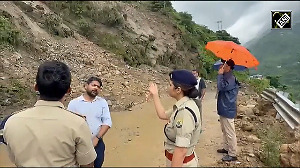It's as if there's a conspiracy to beat India's growth surge to pulp, making sure the economy is hamstrung in the months and years ahead. Those of us seeking rational signals in the economy have watched incredulously as the cost inflation from edible oil, food and energy was misconstrued as overheating from 2006, leading to a series of misguided, self-destructive steps.
Moreover, there has been a baffling obscurantism spread by many different quarters - the RBI, the Finance Ministry, and many economists including from the private sector, the media and press - spouting irrational sophistry about the need for the sledgehammer of rising interest rates "to contain inflationary pressures".
Mutterings about the pass-through of international energy prices are of a piece. The effect of pass-throughs is to increase inflation further, and unlikely to reduce short-term demand (i.e. control inflation), unless the increase is so large that the economy slumps because of a drop in demand.
The build-up with the convoluted explications started with the RBI's nagging suspicion [sic] in October 2006 that there "could be elements of overheating in the Indian economy". This led to the hike of the repo rate from 7 per cent to 7.25 per cent, making financing more expensive in the Indian economy.
By December 2006, the RBI raised the cash reserve ratio (CRR) by 50 basis points to reduce inflationary pressures, and by the end of January 2007, raised the repo rate to 7.5 per cent citing the demand-supply mismatch in food. By March 2007, the repo rate was raised to 7.75 per cent and the CRR by 50 basis points to 6 per cent citing continuing inflationary pressure. In June, the repo rate was raised to 8 per cent.
The benefit of hindsight makes it evident to all of us including the RBI and the government that these measures have done nothing to improve the supply of food or edible oil, or for the surge in petroleum prices. Inflationary pressures are expected to continue into 2009 despite these actions that have slowed the economy.
So, what is the purpose, other than reducing growth precipitously? All that increasing rates and financing costs will do is to kill India's growth story. This shows clearly in the figure in the slowdown from 2007 in GDP growth and in the Index of Industrial Production.
Increasing rates can only curb inflation by reducing growth so much that demand is curtailed for those whose ability to buy food increases because of higher earnings. That's what the obfuscatory talk of "containing demand" boils down to: forcing the economy to slow so that some people can afford to buy less food. It is also clear that by increasing demand through the loan waiver and NREGS without addressing supply constraints, the government's actions increased inflationary pressures. Likewise if the Pay Commission recommendations are implemented now instead of delayed for a year.
What rising financial costs have done to the Indian economy is to vaporise all prospects of high growth and profits. Further aggravated by the global slowdown and the repercussions of the continuing meltdown of home loans and overleveraged US consumers, this has reduced the prospects of currency inflows that have so far provided a ballast to India's dream investment run.
Corrective Actions Require Substance, Less Form: The government and RBI could take a constructive, problem-solving approach to growth, inflation, interest and exchange rates, provided their purpose is solution-oriented and not a preoccupation with appearing to take action. These involve (a) avoiding gamesmanship - loan waivers, NREGS, the imperfections of the PDS - and addressing more effectively (b) fuel taxes and pricing, and (c) supply and distribution.
The first step may be to acknowledge that in the short term, there is little that can be done to ameliorate high food prices with one exception, while taking measures to improve supply over the medium and long term. The exception is interim steps to help the poor through food coupons that enable direct subsidies through existing retail systems.
Over the medium term, a system using smart cards needs to be planned and implemented through the retail network that provides direct subsidies for food and fuel to lower-income users. On fuel, there has to be a concerted move to reduce taxes and remove anomalies in petrol and diesel pricing (i.e. subsidising private vehicle owners, inappropriately encouraging the growth of small diesel vehicle manufacture and sales).
Equally important, we have to learn to take the good examples of applied research and extension to make them more of a reality. It's as simple or as difficult as getting good applied research work done in the field, and providing convincing extension support to local farmers. I had the opportunity recently to review an excellent instance of applied research, combined with sound extension practices that ensure supplies of fresh vegetables wholesale, organised and channelled flawlessly.
Of course, unique aspects make this not easy to replicate. The first is a well-managed farmers' cooperative. This was organised in Ladakh by the late Rigzin Namgyal Kalon of Leh with great foresight, integrity and ability some 40 years ago. Mr Kalon had the ability to see how farmers could prosper by organising themselves for supplying farm produce to the sizeable army presence in Ladakh.
When Mr Kalon passed away in 2002, his peers had the good sense to appeal to his family to continue to lead their effort. The second is a wholesale buyer (the Army). The third is the presence of an institute engaged in effective applied research in agriculture, horticulture and animal husbandry in Ladakh. Started as the Field Research Laboratory under the Defence Research and Development Organisation, this is now the Defence Institute of High Altitude Research. This combination of elements provides the ingredients for a winning formula for the farmers of Ladakh.
Here are object lessons for those who see the potential for cooperatives, but think it cannot work in India. After all, there is Anand (the Gujarat Cooperative Milk Marketing Federation Ltd) and its extension to the National Dairy Development Board to prove that it can be done. We have to stop thinking of shortcuts, learn to replicate these ways, and teach ourselves to collaborate.






